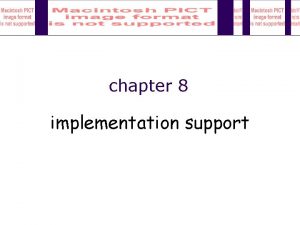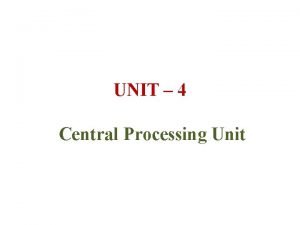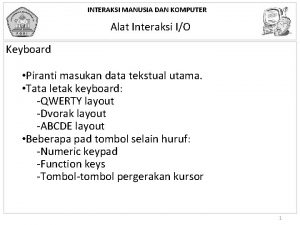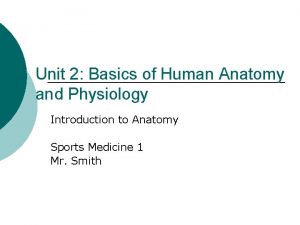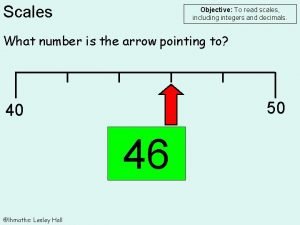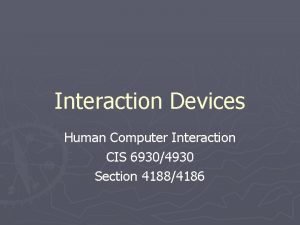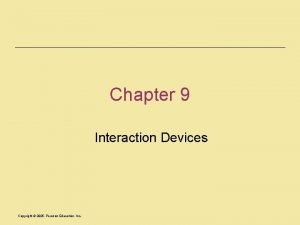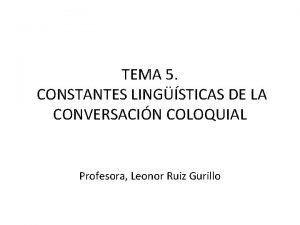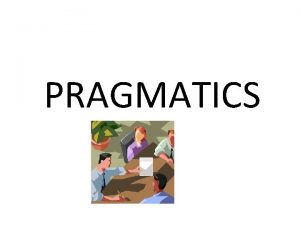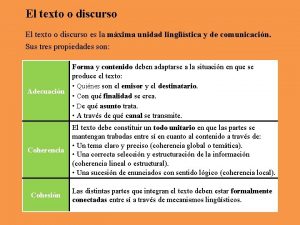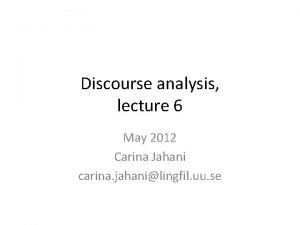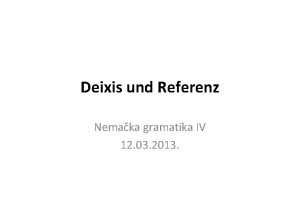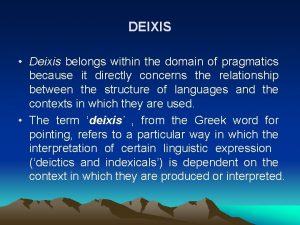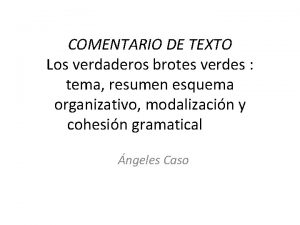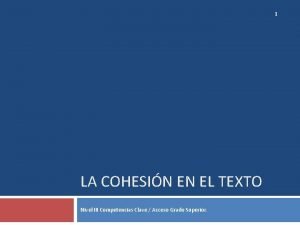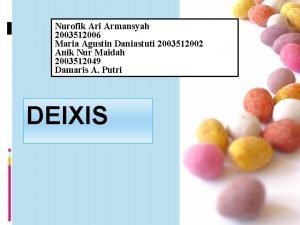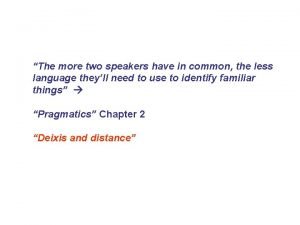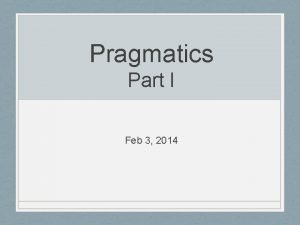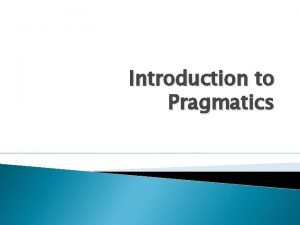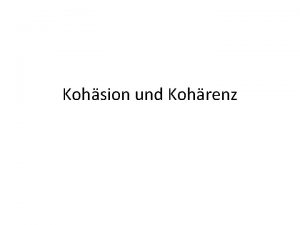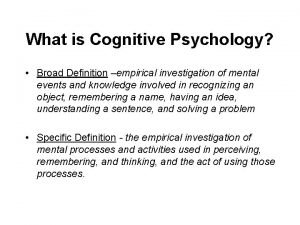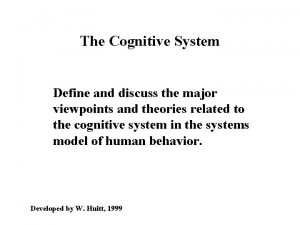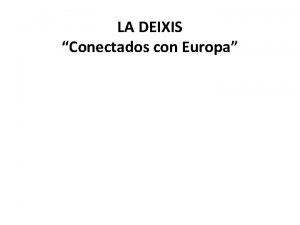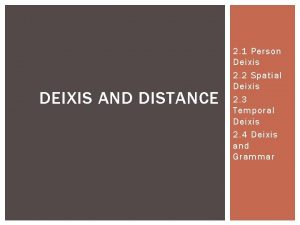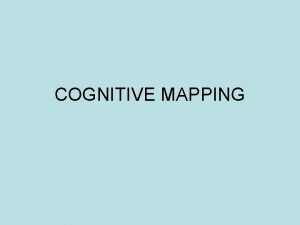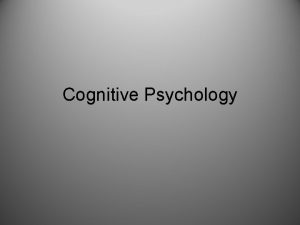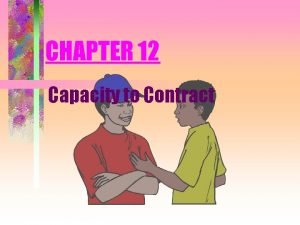Cognitive deixis Deixis meaning pointing is the capacity






























































- Slides: 62

Cognitive deixis

Deixis (meaning “pointing”) is • the capacity that language has for anchoring meaning to a context.

• Deixis has been discussed in philosophy and linguistics for many years. • Deixis is central to the idea of the embodiment of perception, and a cognitive approach offers the possibility of a new and unified answer to these question.

• Process of reading literature (in roles) • real author • T • E • X • T • real reader • Extrafictional voice • Implied author • Narrator(s) • Character(s) Narratee(s) • Implied reader • Idealized reader

• Real authors – flesh-and-blood authors we can speak with • Real readers – WE (flesh-and-blood readers) • Extrafictional voice – Mary Shelley (we believe, that she created Frankenstein, but we can not know her personally, because we have no real access to her) • Narrator – is an invention of Mary Shelley – Dr. Frankenstein, BUT some chapters are narrated by other characters, so characters can play the role of narrator • Implied author – is not your own idea of Mary Shelley, there are different concerns and writing style in the later work, a different implied author. • Character – person of activity in the novel

• Characters speak to other characters, and narrators narrate to an addressee: this addressee at any particular point is the narratee. • Of course, there is an implied reader of Frankenstein`s narrative who sees all of the elements directed at different narratees. This is the reader to whom the novel is directed. • An idealised reader (‘model-reader, ’ ‘informed reader’, ‘super-reader’) is a sort, made by a collection of all possible readings together.

The prototypical deictic categories are founded on the originating deictic centre or zero-point or origo: • the speaker (I), • place (there), • time of utterance (now). Deixis

• Many theorists have limited the discussion of deixis to these egocentric particulars (Bertrand Russell), also called indexicals (Charles Pierce), occasional terms (Edmund Husserl) or shifters (Roman Jakobson). • Deixis is obviously the central concept in the context-dependency of speech. Deixis

• One way of understanding how we can shift our viewpoint to see things as others do or as characters in literature would, is by recognizing our capacity for deictic projection.

• Relational aspect to the participants within the text, in terms how they are socially related to each other, and how each perceptual deictic centre seem to regard other participants. • This is a matter of deixis in the sense that characters in a scenario are socially anchored not absolutely but in relation to each other (f. e. aspects of evaluation to encode the attitude). Relational aspect

• A textual deictic dimension: the poem draws attention to itself as a textual language event in variety of ways.

• There is a deictic aspect in the compositional quality of the text. • Certain generic patterns in word-choice, syntax and register in general have been selected in order to place the poem, to anchor it in a literary tradition, which inevitably is located in relation to other literary works (f. e. using the archaic words in the poem)

Categories of deixis

• Perceptual deixis – expressions concerning the perceptive participants in the text, including: • personal pronouns “I/me/you/they/it”; • demonstratives “these/those”; • definite articles “the man”, • definite references “Bilbo Baggins`”; • mental states “thinking/believing”.

• Spatial deixis – expressions locating the deictic centre in a place, including: • spatial adverbs “here/there”, “nearby/far away”, • locatives “in the valley”, “out of Africa”; • demonstratives “this/that”; • verbs of motion “come/go”, “bring/take”.

• Temporal deixis – expressions locating the deictic centre in time, including: • temporal adverbs “today/tomorrow/soon/later”; • locatives “in my youth”, “after three weeks”; • especially tense and aspect in verb forms that differentiate “speaker-now”, “story-now”, and “receiver-now”.

• Relational deixis – expressions that encode the social viewpoint and relative situations of authors, narrators, characters, and readers, including • modality and expressions of point of view and focalization; • naming and address conventions; • evaluative word-choices (f. e. different styles of narration in attitude to different characters of the novel).

• Textual deixis – expressions that foreground the textuality of the text, including: • explicit ‘signposting’ such as chapter titles and paragraphing; • co-reference to other stretches of text; • reference to the text itself or the act of production; • evidently poetic features that draw attention to themselves; • claims to plausibility, verisimilitude or authenticity.

• Compositional deixis – aspects of the text that manifest the generic type or literary conventions available to readers with the appropriate literary competence. • Stylitic choices encode a deictic relationship between author and literary reader.

SO… AS A CONCLUSION…

• It is important to state that even single words, expressions and sentences can display all of these facets of deixis. • They are only determinable as deixis, qif they are perceived as such by the reader, qif they are seen as anchoring the various entity-roles in participatory relationship.

• Because occurrences of deictic expressions are dependent on context, reading a literary text involves a process of context-creation in order to follow the anchor-points of all these deictic expressions. • Reading is creative in this sense of using the text to construct a cognitively negotiable world, and the process is dynamic and constantly shifting.

Deictic shift theory (DST)

• DST mainly restricts itself to the prototypical deictic situation of egocentric person, place and time. • Its fundamental advance in deictic theory is to place the notion of deictic projection as a cognitive process at the centre of the framework.

• DST models the common perception of a reader ‘getting inside’ a literary text as the reader taking a cognitive stance within the mentally constructed world of the text. • This imaginative capacity is a deictic shift which allows the reader to understand projected deictic expressions relative to the shifted deictic centre.

• In other words, readers can see things virtually from the perspective of the character or narrator inside the text-world, and construct a rich context by resolving deictic expressions from that viewpoint. The notion of the shifted deictic centre is a major explanatory concept to account for the perception and creation of coherence across a literary text.

The key areas of investigation of DST are: • how the deictic centre is created by authors in the text; • how it is shifted; • how it is used dynamically as part of the reading process.

• The world of a literary text consists of one or more deictic fields, which are composed of a whole range of expressions each of which can be categorized as § perceptual, § spatial, § temporal, § relational, § textual, § compositional in nature.

• A set of expressions which point to the same deictic centre can be said to compose a deictic field.

• They are usually arranged around a character, narrator or narratee, the relatively central entity-roles in the text, through of course animals, plants, landscape elements and other objects can also form deictic centres in imaginative literature.

• When a deictic shift occurs, it can be either ‘up’ or ‘down’ the virtual planes of deictic fields.

• In other words, a novel which begins with the deictic field centred on a narrator might shift its deictic centre ‘down’ § to a point earlier in the narrator`s life (shifting deictic centre on the basis largely of the temporal dimension), § or to a different spatial location, § or even to the deictic centre of a character in the novel (with perceptual deixis prominent).

• A push is a type of deictic shift, formed by a term-borrowing from computer science (down-level).

• Moving from being a real reader to perceiving yourself in a textual role as implied reader or narratee, or tracking the perception of a narrator or character, all involve a deictic shift that is a push into a ‘lower’ deictic field.

Entering flashbacks, dreams, plays within plays, stories told by characters, reproduced letters or diary entries inside a novel, or considering unrealised possibilities inside the minds of characters are all examples of pushing into a deictic field.

• A pop is a moving up a level.

• You can pop out of a deictic field by putting a book down and shifting your deictic centre back to your real life level as real reader. • Within a text, you can pop up a level if the narrator appears again at the end to wrap up the narrative, or if the narrator interjects opinion or external comment at any point within the narrative.

• These involve shifts from the character who is the current focus of attention up to ascribe features of the deictic centre to the extrafictional voice is what enables readers to identify and locate irony.

• The sense of ironic motivation is a product of the juxtapositioning of events, the arrangement of plot structure, and compositional mismatches between content and expressions in register. • All of these patterns represent choices by the extrafictional voice.

• Usually, pops and pushes have to be balanced in the narration.

• Shifting deictic centres depends on identifying the boundaries of deictic fields. • The process of identification is called edgework.

The book cover, chapter heading, blank lines or stars between sections, paragraph breaks are the devices of deictic shift.

• Very strong examples of deictic shift cues are spatial and temporal locative expressions and new names of pronouns.

• Perceptual shift – where poetic and literary ‘voices’ are introduced through presentative structure (‘Once there was a girl called Goldilocks’, ‘Into the valley of death rode the six hundred’) and using noun phrases such as proper names. • Perceptual deixis is maintained when the noun phrase is definite and in subject position, and, of course, when the perceptual ‘voice’ is frequently mentioned. • So characters who are constantly named and pronominalised stay current.

• Any perception and mental predicates that are associated with the character also help to maintain that deictic centre. • Perceptual shifts are often preceded by spatial shifts (‘Meanwhile back at the farm, Peter was digging ditches’). • Anti-shifting devices (that is, features which make it unlikely that a perceptual shift will occur) include placing noun phrases in non-subject position, for example, as direct/indirect objects or as complements. • This keeps the character being referred to current in spite of the new subject. Perceptual shift

• Characters can also be kept ‘live’ by subjectchaining (using pronouns to keep the current entityrole live, and by frequent mention). • If potentially new deictic centres are placed into relative clauses, then the subordination stops it becoming the focus of a shift. • Lastly, indefinite subjects are usually not the focus of shifts, as they are more presentative and introductory in nature. Perceptual shift

• Spatial shift – spatial shifts are typically enacted by movement predicates such as verbs of motion: ‘Hannibal crossed the Alps’. • Preposed locative adverbials also shift spatial deixis: ’Somewhere over the rainbow, skies are blue’. • Spatial adverbs (‘here’, ‘there’) introduce and maintain the spatial centre. Spatial shift

• Spatial deixis is maintained, again, by conjoining coordinate clauses to maintain co-reference, as in perceptual deixis. • Spatial elements embedded in relative clauses tend not to shift the centre: ‘I looked at the ship which had travelled across the sea’. • Co-ordinate clauses work for the same reason: ‘I hear you knocking, but you can`t come in’. • Spatial shift is resistant to the effect of perception verbs on their own: a character just thinking about a different place still allows the current location to be maintained. Spatial shift

• Temporal shift – most obviously, any tense and aspect shift and chaining will shift the temporal centre. • Preposed locative adverbials, such as ‘In olden days…’, also act as shifters. • Consistency of tense and aspect maintains the temporal deictic centre. Temporal shift

• Brief departures from the current temporal sequence do not shift the centre if they are introduced with conjunctions. • F. e. ‘I am staying here. I will come when the time is right, but for now I am staying’. • Here, the ‘but’ stops the aspectual from shifting the temporal location to the future. • Embedded past perfects work in a similar way: ‘I was there. I had been before, but now all I wanted was to relax’. Temporal shift

• Relational shift – proper names and address forms (‘Colonel Mustard’, ‘Your Excellency’) serve to mark out relational deictic centres, as do evaluative and judgemental adjectives and adverbials, which indicate a narrative or autorical voice – a sense of a socially situated person ‘speaking’. Relational shift

• Expressions of social politeness and markers of modality (‘it seems to be’, ‘it might be’, ‘may’, ‘will’, ‘would have been’ and so on) also encode the attitudes and social relations of deictic centres. • The maintenance of point of view and a character`s apparent mind-style serve as antishift devices for relational deixis. Relational shift

• Textual shift – titles, chapter titles, epigrams, paragraphing, and other graphology all encode textual deixis, by drawing attention to the evidence for an authorial arrangement. • Similarly, co-reference to other stretches of text by discourse anaphora (‘In the last chapter…’) and the use of predicates from the lexical set of writing, printing or creation (‘I am writing to you from…’) both enact a shift in the textual deictic centre. Textual shift

• Any pop-shifts in perceptual deixis to author, extrafictional voice, implied author or narrator also tend to mark textual shifts, and generic or proverbial sentences draw attention to themselves as textual constructs and thus also have a deictic dimension. • Any text in which the extrafictional voice is prominent (as in Fielding`s Tom Jones), when this perceptual deixis is consistent across the text, will also serve to act as an anti-shift device for textual deixis. Textual shift

• Compositional shift – finally, the external presentational factors (such as the book cover, or a recontextualisation of a text by placing it in a class-room context) can serve to relocate the compositional quality of the discourse. Compositional shift

• Compositional deixis is also marked by any register selections that index a literary convention (such as a fourteen-line sonnet, a cash list at the head of a play, or the dedication of a novel, for example). • Consistency of usage will maintain this composition. Compositional shift

• Shifts in register which could potentially shift the compositional deixis can be made to serve as anti-shift devices if they are framed somehow (for example, by presenting compositions as an in-text quatation or interlude). • Announcement in the interval of a play, for example, are usually understood not to be part of the compositional centre of the surrounding performance. Compositional shift

• Wimsatt “The Intentional Fallacy” • Beardsley “The Affective Fallacy” • Barthes “The Death of the Author” Main scientific works

• • Booth Iser Chatman Riffaterre Eco Fish Bakhtin Scientists entity-roles (the table at the beginning)

Buhler Lyons Levinson the categories of “origo” Jarvella Klein Rauh Green key works on deixis Green Semino application to literature Scientists

• Hewitt • Duchan • Segal • Talmy • Bruder • Wiebe • Zubin Deictic Shift Theory

Thank you for attention!
 Cognitive and non cognitive religious language
Cognitive and non cognitive religious language Design capacity and effective capacity examples
Design capacity and effective capacity examples Telescope pointing model
Telescope pointing model Nbyf uftu sfts sfrs
Nbyf uftu sfts sfrs Support implementation
Support implementation Alberto giacometti pointing man
Alberto giacometti pointing man What is metacommentary
What is metacommentary The diamond shape is used exclusively for
The diamond shape is used exclusively for Flush grooved pointing
Flush grooved pointing What is the arrow pointing to
What is the arrow pointing to A pointing device
A pointing device What is the answer
What is the answer Structure of leaf diagram
Structure of leaf diagram Contoh indirect pointing devices
Contoh indirect pointing devices Interaksi manusia komputer
Interaksi manusia komputer Sum of angles of pentagon
Sum of angles of pentagon Sagittial
Sagittial A handheld pointing device
A handheld pointing device 4 automatic input devices
4 automatic input devices Identify arrows pointing to bonding electrons.
Identify arrows pointing to bonding electrons. Pointing vector
Pointing vector Diagnosis topis vertigo
Diagnosis topis vertigo What is the arrow pointing to
What is the arrow pointing to Vestibular migraine
Vestibular migraine Sse keypad
Sse keypad Elevasi adalah
Elevasi adalah Pointing devices in hci
Pointing devices in hci Direct control pointing devices
Direct control pointing devices Deixis temporal
Deixis temporal Pragmatics
Pragmatics Deixis
Deixis Co text
Co text Que es la correferencia
Que es la correferencia Adecuación ejemplos
Adecuación ejemplos Coherencia global
Coherencia global Discourse deixis examples
Discourse deixis examples Deixis aussprache
Deixis aussprache Deixis definition
Deixis definition Deixis nedir
Deixis nedir Modalizacion comentario de texto
Modalizacion comentario de texto Ejemplo de deixis
Ejemplo de deixis What is deixis in asl
What is deixis in asl Hiperonimia
Hiperonimia Empathetic deixis
Empathetic deixis Discourse deixis
Discourse deixis Deictic expressions
Deictic expressions Direct speech exercise
Direct speech exercise Deixis aussprache
Deixis aussprache Cognitive meaning in psychology
Cognitive meaning in psychology Cognitive system meaning
Cognitive system meaning Meaning of cognitive flexibility
Meaning of cognitive flexibility Hình ảnh bộ gõ cơ thể búng tay
Hình ảnh bộ gõ cơ thể búng tay Ng-html
Ng-html Bổ thể
Bổ thể Tỉ lệ cơ thể trẻ em
Tỉ lệ cơ thể trẻ em Voi kéo gỗ như thế nào
Voi kéo gỗ như thế nào Tư thế worm breton
Tư thế worm breton Alleluia hat len nguoi oi
Alleluia hat len nguoi oi Các môn thể thao bắt đầu bằng tiếng bóng
Các môn thể thao bắt đầu bằng tiếng bóng Thế nào là hệ số cao nhất
Thế nào là hệ số cao nhất Các châu lục và đại dương trên thế giới
Các châu lục và đại dương trên thế giới Công thức tính độ biến thiên đông lượng
Công thức tính độ biến thiên đông lượng Trời xanh đây là của chúng ta thể thơ
Trời xanh đây là của chúng ta thể thơ




